- Growing Cyclamen from Seeds
- Understanding Cyclamen Species
- 1. Cyclamen Persicum
- 2. Cyclamen Hederifolium
- 3. Cyclamen Coum
- 4. Cyclamen Graecum
- 5. Cyclamen Purpurascens
- The Ideal Conditions for Cyclamen Growth
- Temperature
- Light
- Humidity
- Watering
- Soil
- Fertilization
- Overwintering
- Tips for Watering Cyclamen Plants
- Caring for Cyclamen During Different Seasons
- Spring
- Summer
- Fall
- Winter
- Common Pests and Diseases that Affect Cyclamen
- Pests
- Diseases
- Creative Uses for Cyclamen in Home Decor
- 1. Centerpiece
- 2. Hanging Display
- 3. Window Sill Decor
- 4. Gift Decoration
- 5. Terrarium Accent
- 6. Table Setting
- 7. Bathroom Decor
- 8. Wall Art
- Interesting Facts and Trivia about Cyclamen
- Varieties
- The Language of Cyclamen
- Cultivation and Care
- Fun Facts
- Q&A:
- How long does it take for cyclamen seeds to germinate?
- What is the best time to sow cyclamen seeds?
- Do cyclamen seeds need light to germinate?
- Can all species of cyclamen be grown from seeds?
- How often should I water cyclamen seeds?
- How long does it take for cyclamen seeds to flower?
- What is the ideal temperature for germinating cyclamen seeds?
- Video: how to germinate cyclamen seeds Part 1
Cyclamen is a beautiful and delicate flowering plant that is native to the Mediterranean region. It is known for its unique and vibrant flowers, which can come in a variety of colors including pink, purple, and white. Growing cyclamen from seeds can be a rewarding and enjoyable experience for gardeners of all skill levels.
When growing cyclamen from seeds, it is important to start with high-quality seeds. These can be purchased from a reputable supplier or collected from mature plants. Once you have your seeds, you will need to properly prepare the soil. Cyclamen prefers well-draining soil that is rich in organic matter. Adding compost or peat moss can help improve the soil’s texture and fertility.
Once the soil is prepared, it is time to plant the seeds. Cyclamen seeds are small and can be easily sown directly into the soil. They should be planted at a depth of about 1/4 inch and spaced about 2 inches apart. After planting, the seeds should be watered thoroughly to ensure proper germination.
After planting, it is important to provide the seeds with the right growing conditions. Cyclamen prefers cool temperatures and indirect sunlight. A temperature range of 50-60 degrees Fahrenheit (10-15 degrees Celsius) is ideal for germination and growth. The plants should also be protected from excessive heat, which can cause wilting and damage to the foliage.
With proper care and attention, cyclamen seeds will germinate and grow into beautiful and healthy plants. It is important to water the plants regularly, but be careful not to overwater as this can lead to root rot. Fertilizing the plants every 2-4 weeks with a balanced fertilizer can help promote healthy growth and vibrant blooms.
In addition to their beauty, cyclamen plants are also known for their ability to purify the air and improve indoor air quality. They are a popular choice for indoor gardens and can be grown in containers and hanging baskets. With their stunning flowers and easy care requirements, cyclamen is a must-have plant for any gardener.
Overall, growing cyclamen from seeds can be a rewarding and enjoyable experience. With the proper preparation, care, and attention, you can watch your cyclamen seeds grow into beautiful and vibrant plants. Whether you are a seasoned gardener or just starting out, cyclamen is a great addition to any garden or indoor space.
Growing Cyclamen from Seeds
Growing cyclamen from seeds can be a rewarding experience for any gardener. With proper care and attention, these beautiful flowers can bloom and thrive in your garden. Here are the steps to grow cyclamen from seeds:
- Sourcing the seeds: You can purchase cyclamen seeds from a reputable garden center or online. Make sure to choose seeds from a trusted source to ensure their viability.
- Preparing the soil: Cyclamen prefers well-draining soil that is rich in organic matter. Prepare the soil by mixing in compost or well-rotted manure to improve its fertility.
- Sowing the seeds: Fill a seed tray with the prepared soil, leaving a small gap at the top. Sprinkle the cyclamen seeds evenly on top of the soil and lightly press them in. Cover the seeds with a thin layer of vermiculite or a fine layer of soil.
- Maintaining moisture: Place the seed tray in a warm and bright location, but not in direct sunlight. Keep the soil consistently moist by misting it with water or using a gentle watering can. Avoid overwatering as it can lead to rotting.
- Germination: Cyclamen seeds typically germinate in 2 to 3 weeks. Once you see the seedlings emerge, you can remove the cover or plastic wrap from the seed tray. Continue to water the seedlings as needed to maintain moisture.
- Transplanting: When the cyclamen seedlings have grown two or three true leaves, they can be transplanted into individual pots or containers. Gently lift the seedlings from the tray, being careful not to damage the fragile roots, and replant them at a similar depth in the new container.
- Care and maintenance: Place the potted cyclamen in a cool location with bright but indirect light. Water the plants from the bottom by placing the pots in a tray of water until the soil is moist. Avoid wetting the leaves and flowers as it can cause rot. Cyclamen prefers cooler temperatures and will thrive in a range of 50-65°F (10-18°C).
- Blooming and fertilization: With proper care, your cyclamen plants should start blooming in about 4-5 months. To encourage continuous blooming, fertilize the plants every 2-4 weeks with a balanced liquid fertilizer formulated for flowering plants.
Growing cyclamen from seeds is a rewarding process that allows you to enjoy the beauty of these delicate flowers. With patience and proper care, you can successfully grow cyclamen from seeds in your garden or indoor space.
Understanding Cyclamen Species
Cyclamen is a genus of flowering plants that belongs to the family Primulaceae. There are about 20 different species of cyclamen, each with its own unique characteristics and growing requirements. Understanding the different species can help gardeners choose the right cyclamen for their garden.
1. Cyclamen Persicum
Cyclamen persicum, also known as florist’s cyclamen or Persian cyclamen, is the most widely grown species of cyclamen. It is native to the Mediterranean region and is known for its highly decorative flowers. The flowers range in color from white to pink to red and have beautifully patterned petals. Cyclamen persicum is a popular houseplant and can be grown both indoors and outdoors.
2. Cyclamen Hederifolium
Cyclamen hederifolium, commonly known as ivy-leaved cyclamen, is a hardy species that is native to Europe and the Mediterranean. It gets its name from the ivy-like shape of its leaves. Cyclamen hederifolium flowers in the fall, producing delicate pink or white flowers. It is a popular choice for naturalizing in woodland gardens and is well-loved for its tolerance to shade.
3. Cyclamen Coum
Cyclamen coum, also known as eastern sowbread, is a small and compact species that is native to parts of Europe and the Caucasus. It has rounded leaves with silver marbling and produces charming pink or purple flowers in the winter. Cyclamen coum prefers cool, moist conditions and is often grown as a ground cover or in rock gardens.
4. Cyclamen Graecum
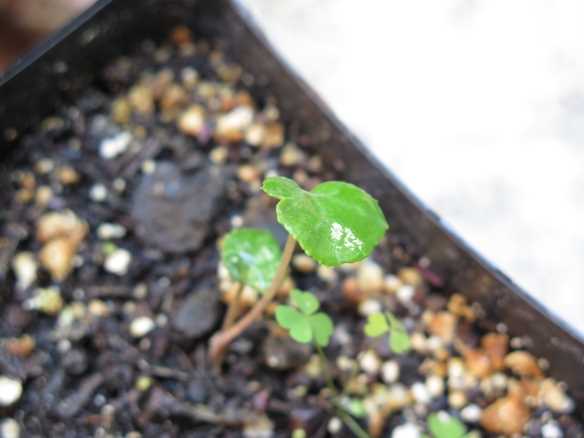
Cyclamen graecum, native to Greece and Turkey, is a species that thrives in dry, rocky habitats. It has large, heart-shaped leaves and produces fragrant flowers that range in color from pale pink to deep purple. Cyclamen graecum is a popular choice for gardeners looking to add a touch of Mediterranean flair to their gardens.
5. Cyclamen Purpurascens
Cyclamen purpurascens, also known as the alpine cyclamen, is native to the alpine regions of central Europe. It has deeply divided leaves and produces fragrant pink or lavender flowers. Cyclamen purpurascens is a hardy species that can withstand cold temperatures and is often grown in rock gardens or alpine plantings.
| Species | Native Region | Flower Color | Growth Habits |
|---|---|---|---|
| Cyclamen persicum | Mediterranean | White, Pink, Red | Indoor/Outdoor |
| Cyclamen hederifolium | Europe, Mediterranean | Pink, White | Hardy, Shade Tolerant |
| Cyclamen coum | Europe, Caucasus | Pink, Purple | Cool, Moist Conditions |
| Cyclamen graecum | Greece, Turkey | Pale Pink, Deep Purple | Dry, Rocky Habitats |
| Cyclamen purpurascens | Central Europe | Pink, Lavender | Hardy, Cold Tolerant |
By understanding the different species of cyclamen, gardeners can choose the right cultivars to suit their climate, growing conditions, and aesthetic preferences. Whether you’re looking for a showy indoor plant or a hardy ground cover, there is a cyclamen species that will thrive in your garden.
The Ideal Conditions for Cyclamen Growth
Creating the ideal conditions for cyclamen growth is essential for ensuring the health and vibrancy of these beautiful plants. By providing the right environment, you can help your cyclamen thrive and produce stunning flowers. Here are some key factors to consider:
Temperature
- Cyclamen plants prefer cool temperatures ranging from 50°F to 60°F (10°C to 15°C).
- Avoid exposing your cyclamen to extreme heat or cold, as this can cause stress and damage to the plant.
Light
- Place your cyclamen in a bright location with indirect sunlight.
- Avoid placing them in direct sunlight, as this can lead to leaf burn.
- If you notice the leaves of your cyclamen becoming pale or yellow, it may be an indication that it is receiving too much light.
Humidity
- Cyclamen plants prefer humidity levels between 50% and 60%.
- If the air in your home is dry, you can increase humidity by placing the pot on a tray filled with water and pebbles.
Watering
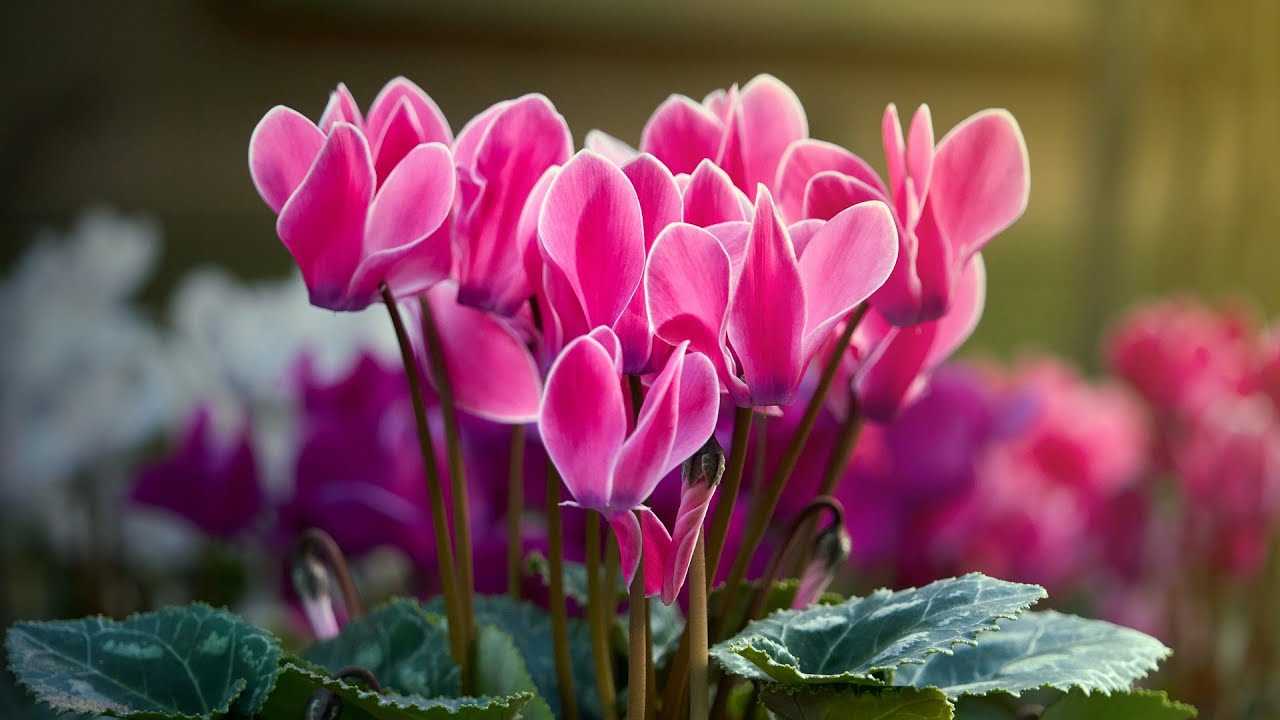
- Water your cyclamen thoroughly, allowing the soil to dry slightly between waterings.
- Avoid overwatering, as this can lead to root rot.
- It is best to water from the bottom by placing the pot in a tray of water and allowing the plant to soak up the moisture.
Soil
- Cyclamen plants prefer a well-draining soil mixture.
- Use a potting mix that is specifically formulated for cyclamen or create your own by combining equal parts peat moss, perlite, and sand.
- Avoid using heavy or compacted soil, as this can lead to waterlogged roots.
Fertilization
- Feed your cyclamen with a balanced, water-soluble fertilizer every four to six weeks during the growing season.
- Be sure to follow the instructions on the fertilizer package for the correct dosage and application method.
Overwintering
- Cyclamen plants typically go dormant during the summer months.
- To encourage dormancy, reduce watering and move your cyclamen to a cool, dark location.
- Resume regular care in the fall when new growth appears.
By providing the ideal conditions outlined above, you can help your cyclamen plants thrive and enjoy their beautiful blooms throughout the year.
Tips for Watering Cyclamen Plants
- Watering Frequency: Cyclamen plants have specific water needs and overwatering can be detrimental to their health. Watering should be done only when the soil feels dry to the touch. It is essential to avoid waterlogged conditions.
- Watering Method: When watering cyclamen plants, it is important to water them from below. Place the pot in a tray filled with water and let the plant soak up the water through the drainage holes in the bottom of the pot. This prevents water from sitting on the delicate leaves and causing damage.
- Water Quality: Cyclamen plants are sensitive to the quality of water used for watering. It is best to use distilled water or rainwater, as tap water can contain minerals and chemicals that may harm the plant. Avoid using water that has been treated with water softeners.
- Monitoring Watering Needs: It is important to regularly check the moisture level of the soil to ensure that the plant is receiving adequate water. Inserting a finger about an inch into the soil can help determine if watering is needed. If the soil feels dry, it is time to water the plant.
- Avoiding Wet Foliage: Water should be directed towards the base of the plant and not on its leaves. Wet foliage can lead to the development of fungal diseases and rot. It is best to use a watering can with a long spout to target the water at the base of the plant.
- Drainage: Proper drainage is crucial for the health of cyclamen plants. Ensure that the pot has drainage holes to allow excess water to escape. Standing water in the pot can lead to root rot and other problems.
- Temperature and Watering: Pay attention to the temperature of the surrounding environment when watering cyclamen plants. Cooler temperatures may require less frequent watering, while warmer temperatures may necessitate more frequent watering.
- Seasonal Variations: Cyclamen have different water requirements depending on the season. During the dormant period in summer, reduce watering and allow the plant to dry out slightly. During the active growing season, increase watering as needed.
- Misting: Misting the air around cyclamen plants can help increase humidity levels. However, misting the plant directly can cause water to collect on the leaves, leading to the development of rot. It is best to mist the area around the plant instead of the plant itself.
- Observe and Adjust: Lastly, observing the plant and its response to watering is important in understanding its specific needs. Adjust the watering frequency and amount as per the plant’s requirements and environmental conditions.
Caring for Cyclamen During Different Seasons
Cyclamen is a delicate and beautiful flowering plant that requires special care during different seasons. Here are some tips on how to care for cyclamen throughout the year:
Spring
- Watering: In spring, cyclamen enters a dormancy phase. Reduce watering and allow the topsoil to dry out between waterings.
- Temperature: Cyclamen prefers cool temperatures during spring. Keep the plant in a room with a temperature range of 50-60°F (10-15°C).
- Light: Provide bright, indirect light to the cyclamen plant during spring. Avoid placing it in direct sunlight.
Summer
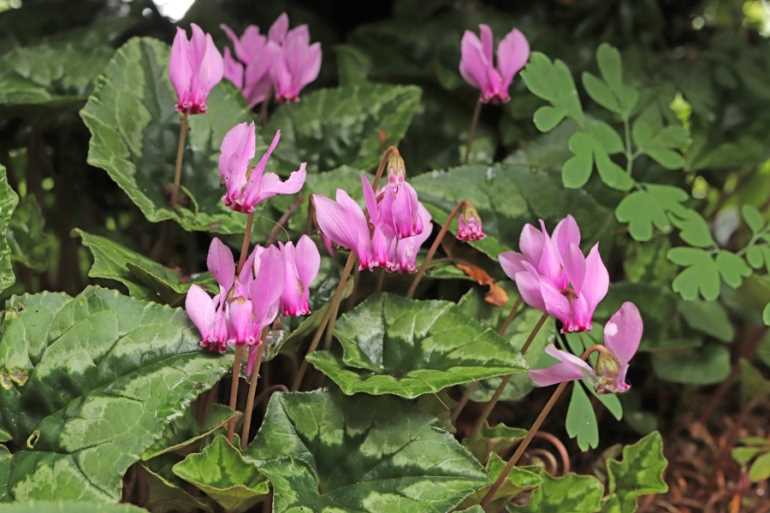
- Watering: In summer, cyclamen goes into summer dormancy. Reduce watering further and allow the soil to become almost dry. Avoid overwatering.
- Temperature: Cyclamen prefers cooler temperatures even during summer. Keep the plant in a well-ventilated area with a temperature range of 60-70°F (15-20°C).
- Light: During summer, provide indirect or filtered light to the cyclamen plant. Protect it from direct sunlight, as it can scorch the leaves.
Fall
- Watering: Increase watering slightly as the cyclamen enters the active growth period in fall. Keep the soil moist but not waterlogged.
- Temperature: Cyclamen prefers cooler temperatures during fall. Maintain a room temperature range of 60-65°F (15-18°C).
- Light: Provide bright, indirect light to the cyclamen plant during fall. Avoid exposing it to direct sunlight.
Winter
- Watering: In winter, water the cyclamen sparingly, keeping the soil slightly moist. Avoid overwatering, as it can cause root rot.
- Temperature: Cyclamen thrives in cooler temperatures during winter. Maintain a room temperature range of 50-60°F (10-15°C).
- Light: During winter, provide bright, indirect light to the cyclamen plant. Avoid placing it in a location with fluctuating temperatures or drafts.
By following these care tips, you can ensure your cyclamen plant remains healthy and blooming throughout the year.
Common Pests and Diseases that Affect Cyclamen
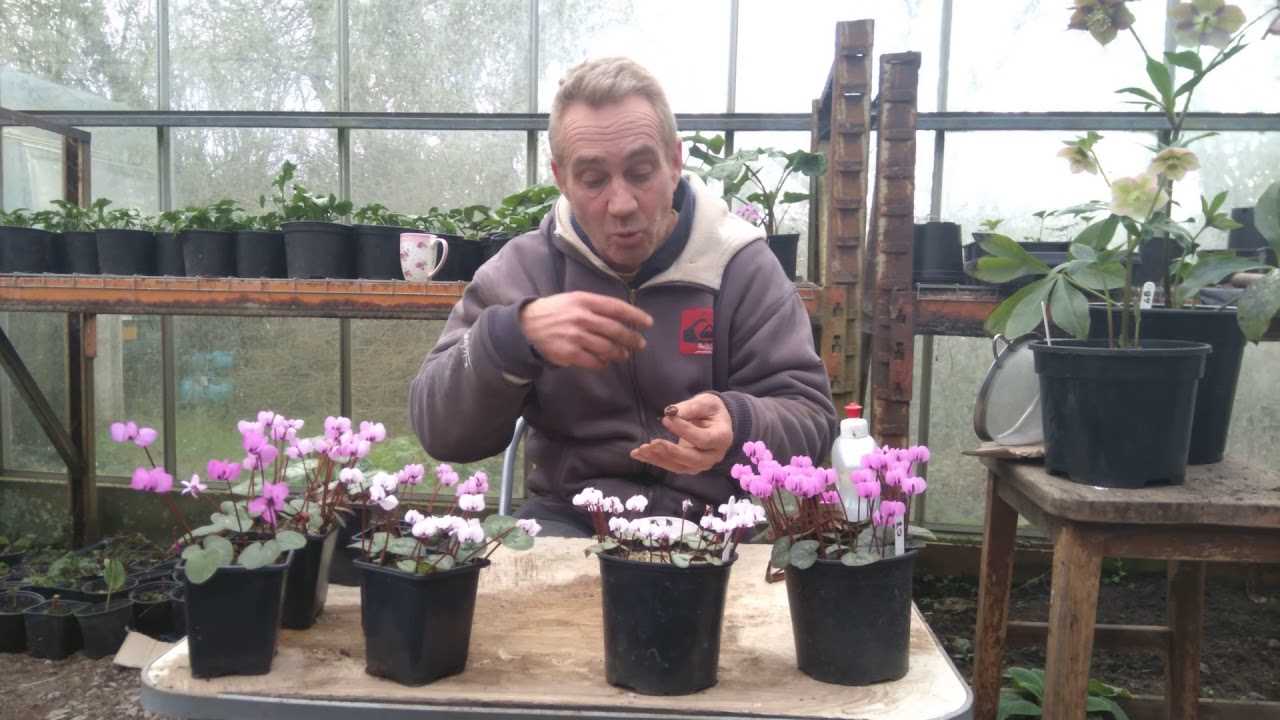
While cyclamen plants are generally resilient and hardy, they can still be susceptible to certain pests and diseases. It is important for gardeners to be aware of these issues in order to prevent and treat them effectively.
Pests
Aphids: Aphids are small, soft-bodied insects that often attack cyclamen plants by sucking the sap from their leaves and stems. They can cause wilting, yellowing, and distorted growth. To control aphids, you can use insecticidal soap or spray them off with a strong stream of water.
Spider mites: Spider mites are tiny pests that feed on plant tissues, causing yellowing, stippling, and webbing on the leaves. Regularly misting your cyclamen and keeping the humidity high can help prevent spider mite infestations. If infested, you can use insecticidal soap or a miticide to control them.
Thrips: Thrips are small, slender insects that feed on the flowers and leaves of cyclamen. They can cause silvering, distortion, and discoloration. You can control thrips by removing any infested flowers or leaves and using insecticidal soap or neem oil.
Diseases
Rhizome rot: Rhizome rot is a fungal disease that affects the roots and rhizomes of cyclamen plants. It is usually caused by overwatering or poor drainage. To prevent rhizome rot, make sure to plant cyclamen in well-draining soil and avoid overwatering. If the disease is present, you may need to remove affected plants and treat the remaining ones with a fungicide.
Gray mold: Gray mold is a common fungal disease that can affect cyclamen plants, particularly in humid conditions. It causes grayish-brown fuzzy patches on the leaves and flowers. To prevent gray mold, make sure to provide good air circulation and avoid overhead watering. If the disease occurs, remove affected plant parts and apply a fungicide to the remaining plants.
Leaf spot: Leaf spot is a bacterial or fungal disease that causes dark spots on the leaves of cyclamen plants. It can be caused by overwatering, poor sanitation, or high humidity. To prevent leaf spot, water the plants at the base and avoid wetting the leaves. If leaf spot occurs, remove affected leaves and apply a fungicide.
Virus infections: Cyclamen plants can also be susceptible to various virus infections, such as cyclamen mottle virus and tomato spotted wilt virus. These viruses are usually spread by infected aphids or through contaminated gardening tools. Unfortunately, there is no effective treatment for virus-infected plants, and they should be removed to prevent the spread of the virus to other plants.
By being vigilant and taking appropriate measures, you can help keep your cyclamen plants healthy and free from pests and diseases.
Creative Uses for Cyclamen in Home Decor
Cyclamen, with its delicate blooms and vibrant colors, can add a touch of beauty and elegance to any home decor. Here are some creative ways to incorporate cyclamen into your interior design:
1. Centerpiece
Use a small cyclamen plant as the focal point of a table centerpiece. Place it in a decorative pot or vase and surround it with complementary elements, such as candles or other small potted plants, for a stunning display.
2. Hanging Display
Hang a cyclamen plant in a decorative hanging basket or macrame holder. This not only adds a unique touch to your decor, but also allows the cyclamen blooms to cascade downwards for an eye-catching display.
3. Window Sill Decor
Place a row of cyclamen plants on your window sill to create a beautiful and colorful display. Choose different colors and varieties to add visual interest and create a vibrant focal point in any room.
4. Gift Decoration
Enhance your gift-giving by using cyclamen flowers as decorative accents. Attach a small cyclamen bloom or leaf to a gift box or bag to add a pop of color and elegance. It will make your gift stand out and show extra thoughtfulness.
5. Terrarium Accent
Add a cyclamen plant to a mini terrarium to create a whimsical and enchanting display. The cyclamen’s delicate blooms will contrast beautifully with the greenery and other elements in the terrarium, creating a natural and mesmerizing scene.
6. Table Setting
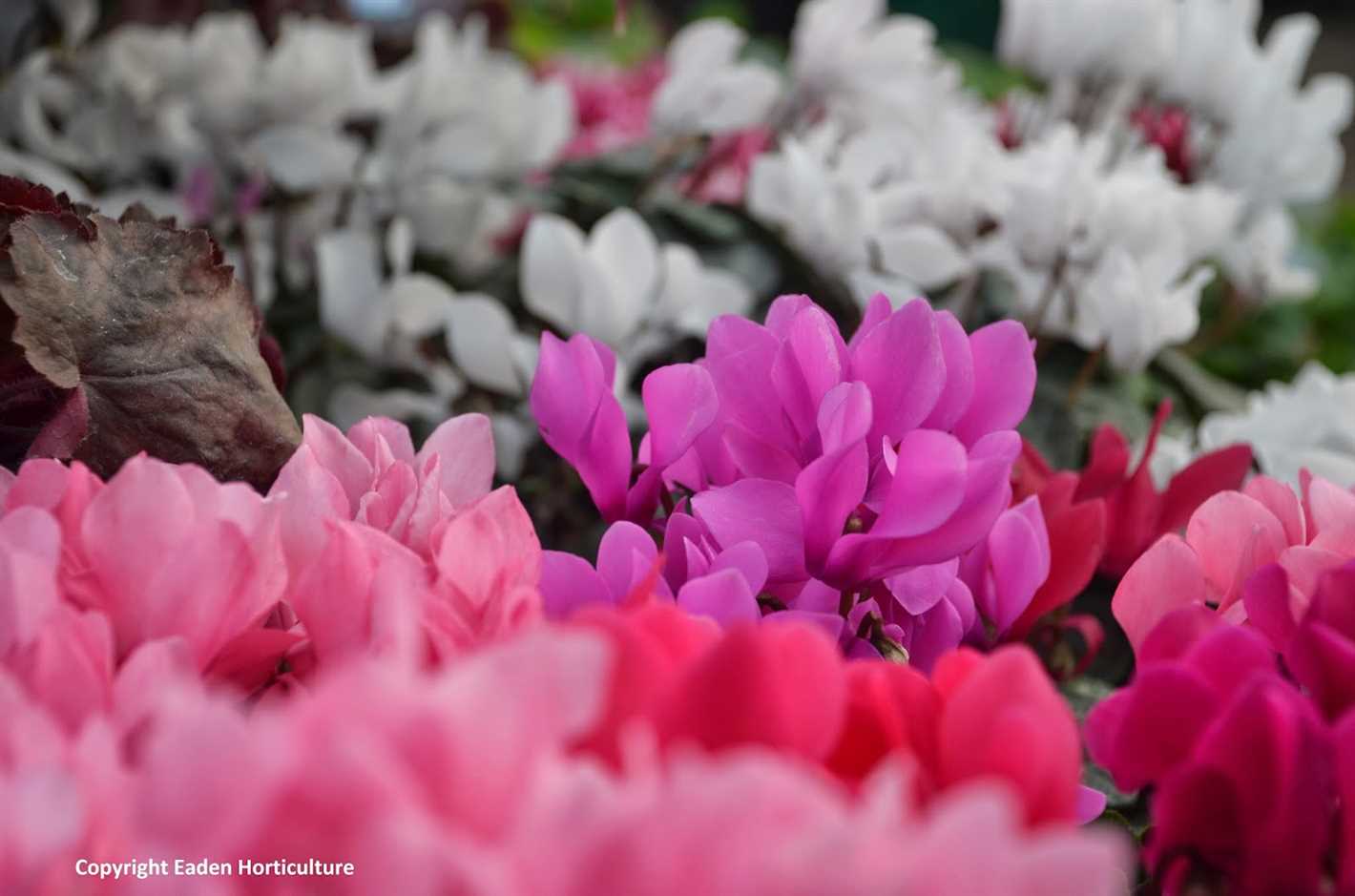
Use cyclamen flowers as part of your table setting for a special occasion or a romantic dinner. Place individual blooms or small potted cyclamen plants at each place setting to create a luxurious and enchanting ambiance.
7. Bathroom Decor
Bring the beauty of cyclamen into your bathroom by placing a small potted plant on the vanity or near the bathtub. The cyclamen’s vibrant colors and delicate blooms will add a touch of elegance and freshness to your bathroom decor.
8. Wall Art
Create a unique and artistic wall art display using dried cyclamen blooms. Press the blooms between two pieces of glass or use them to decorate a shadow box. Hang the finished piece on the wall for a stunning and nature-inspired artwork.
These are just a few creative ideas for incorporating cyclamen into your home decor. From centerpieces to wall art, cyclamen can bring beauty and elegance to any room in your home.
Interesting Facts and Trivia about Cyclamen
- Cyclamen is a genus of flowering plants that belongs to the family Primulaceae.
- The name “cyclamen” is derived from the Greek word “kyklos,” meaning circle, referring to the round tuber of the plant.
- Cyclamen plants are native to Mediterranean regions, including parts of Europe, Western Asia, and North Africa.
Varieties
There are several species and varieties of cyclamen, including:
- Cyclamen persicum: Also known as florist’s cyclamen, this is the most popular species cultivated for indoor use. It has attractive flowers in a range of colors, including pink, red, and white.
- Cyclamen hederifolium: This species is known for its beautiful foliage, which has variegated patterns resembling ivy leaves. It blooms in late summer and early autumn with delicate pink or white flowers.
- Cyclamen coum: Native to the Mediterranean, this species produces flowers ranging from pink to deep purple during the winter months. It is well-suited for rock gardens and naturalizing in woodland areas.
The Language of Cyclamen
In the language of flowers, cyclamen symbolizes lasting affection and sincere love. It is often used as a gift for Valentine’s Day or to express gratitude.
Cultivation and Care
Cyclamen plants prefer cool temperatures and well-drained soil. They thrive in partial shade and require regular watering during their active growth period. Overwatering can lead to rot, so it’s important to allow the soil to dry partially between waterings. After blooming, cyclamen enters a dormant phase and should be kept dry until new growth appears.
Fun Facts
- Cyclamen seeds are dispersed by ants, which are attracted to the fleshy coating.
- The tubers of cyclamen plants can live for many years, with some reaching a hundred years or more.
- In some cultures, cyclamen is believed to have medicinal properties and is used as a treatment for various ailments.
| Common Name | Scientific Name |
|---|---|
| Florist’s Cyclamen | Cyclamen persicum |
| Ivy-Leaved Cyclamen | Cyclamen hederifolium |
| Round-Leaved Cyclamen | Cyclamen coum |
Q&A:
How long does it take for cyclamen seeds to germinate?
Cyclamen seeds typically take about 3-6 weeks to germinate.
What is the best time to sow cyclamen seeds?
The best time to sow cyclamen seeds is in the late summer or early fall.
Do cyclamen seeds need light to germinate?
No, cyclamen seeds do not need light to germinate. It is best to cover the seeds with a thin layer of soil or vermiculite.
Can all species of cyclamen be grown from seeds?
Yes, all species of cyclamen can be grown from seeds.
How often should I water cyclamen seeds?
Cyclamen seeds should be kept consistently moist, but not overly wet. It is best to water them from below to avoid causing any damage to the seeds.
How long does it take for cyclamen seeds to flower?
Cyclamen seeds typically take about 2-3 years to flower.
What is the ideal temperature for germinating cyclamen seeds?
The ideal temperature for germinating cyclamen seeds is around 60-65°F (15-18°C).
Video:
how to germinate cyclamen seeds Part 1







